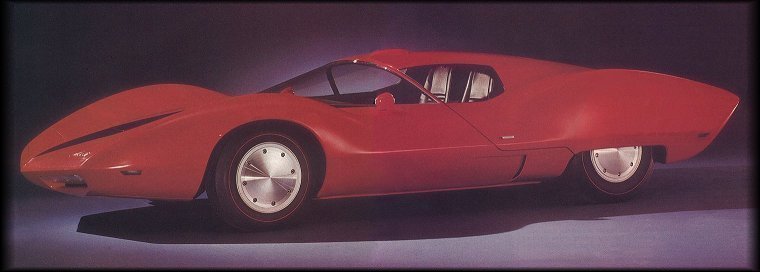

![]()
Astro-I Design Study
|
The upper body of the Astro-I was constructed of fiberglass, in two sections. The front, comprised of the nose, front fenders and windshield, was fixed. A small access panel ahead of the windshield enabled access to the battery, the braking system's dual master cylinder, and the windshield washer reservoir. A large, single windshield wiper was housed beneath doors at the base of the windshield. |
|
The rear portion of the body, fenders and canopy, pivoted from a point behind the rear wheels and was raised and lowered electrically using a jackscrew to allow cockpit entry and egress. The seats rose with the canopy, and lowered to a semi-reclining position as the canopy was closed. A mechanical release mechanism was provided for emergency exit. A positive ventilation system drew outside air from a vent in the high pressure area ahead of the windshield and directed it to air outlets behind the driver and passenger. The Astro-I was also equipped with a fully automatic air conditioning and heating system. Cockpit controls and instrumentation included twin-grip steering control, a 160 MPH speedometer, 9000 RPM tachometer, oil pressure, charging system, cylinder head temperature and fuel gauges. An array of warning lights kept the driver informed of safety related events such as seat belt and canopy lock status. Others warned of high cylinder head temperatures or low oil pressure. |
 |
|
An interesting feature of the Astro-I was the rear view mirror arrangement. The bubble on the roof housed a 3-element mirror system which allowed a view over the back of the car. Standard external fender-mount mirrors augmented the view. Forward vision was exceptional, due to the wrap-around windshield and narrow pillars. |

|
Dimensions |
|
Wheelbase: |
88.0" |
Overall length: |
176.75" |
|
Front tread: |
54.68" |
Overall width: |
72.24" |
|
Rear tread: |
55.9" |
Overall height: |
35.5" |
|
|
|
Astro-I exists today and is stored by General Motors and featured at prestigious car shows such as the Eyes On Design show held in Warren, Michigan every summer. Remember Shinoda, his incredible talent and immense contribution to Corvette and Corvair design. He remained active in design until shortly before his death due to heart and kidney failure on November 13, 1997, at the age of 65. |
|
|
Special thanks to Wayne Ellwood |

Select from the navigation bar!